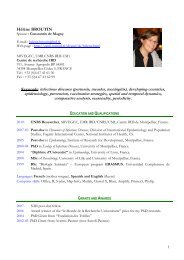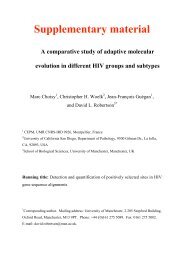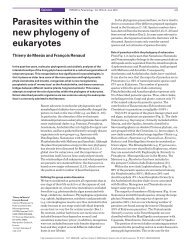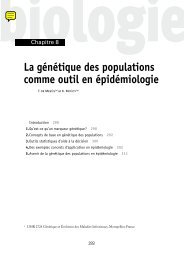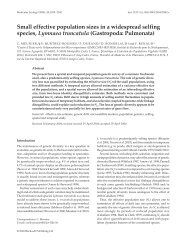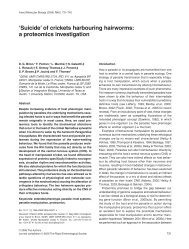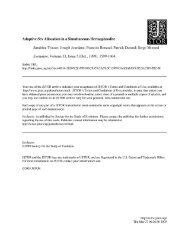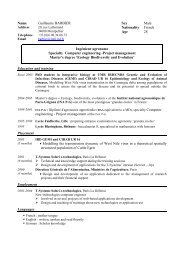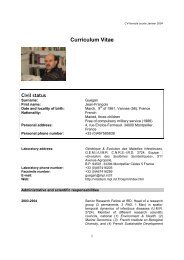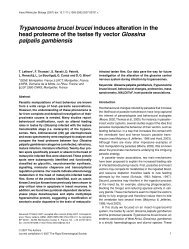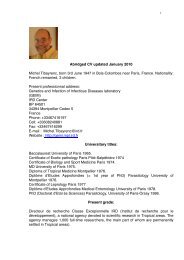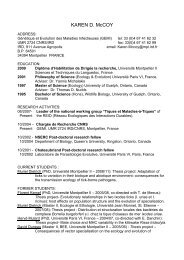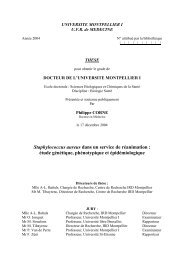écologie des virus influenza aviaires en Camargue - IRD
écologie des virus influenza aviaires en Camargue - IRD
écologie des virus influenza aviaires en Camargue - IRD
Create successful ePaper yourself
Turn your PDF publications into a flip-book with our unique Google optimized e-Paper software.
« The ecological significance of manipulative parasites »53 Piscart, C. et al. (2007) An acanthocephalan parasite increases the salinity tolerance ofthe fresh water amphipod Gammarus roeseli (Crustacea: Gammaridae)Naturwiss<strong>en</strong>schaft<strong>en</strong> 94, 74174754 Devin, S. and Beisel, JN. (2007) Biological and ecological characteristics of invasivespecies: a gammarid study. Biol. Invasion 9, 132455 Plaistow, S. et al. (2001) The effect of the acanthocephalan parasite Pomphorhynchuslaevis on the lipid and glycog<strong>en</strong> cont<strong>en</strong>t of its intermediate host Gammarus pulex. Int. J.Parasitol. 31, 34635156 Amat, F. et al. (1991) Some aspects of Artemia biology affected by cestode parasitism.Hydrobiol. 212, 2944.57 Sanchez, M. et al. (2008) Neurological and physiological disorders in Artemia harbouringmanipulative cesto<strong>des</strong>. J Parasitol. In press58 Helluy, S. (1983) Un mode de favorisation de la transmission parasitaire : la manipulationdu comportem<strong>en</strong>t de l'hôte intermediaire. Rev. Ecol. 38, 21122359 Aeby, G.S. (1991) Behavioral and ecological relationships of a parasite and its hostswithin a coral reef system. Pac. Sci. 45, 263–26960 Yanoviak, S.P. et al. (2008) Parasiteinduced fruit mimicry in a tropical canopy ant. Am.Nat. 171, 53654461 Thomas, F. et al. (2002) Do Hairworms (Nematomorpha) manipulate their terrestrial hostto seek water ? J. Evol. Biol. 15, 35636162 Lefèvre, T. and Thomas, F. (2008) Behind the sc<strong>en</strong>e something else is pulling the strings:Emphasizing parasitic manipulation in vectorborne diseases. Inf. G<strong>en</strong>et. Evol. 8, 50451963 Scott, M.E. (1987) Regulation of mouse colony abundance by Heliogomosomoi<strong>des</strong>polygyrus (Nematoda). Parasitology 89, 15919464 Hudson, P.J. et al. (2002) Trophic interactions and population growth rates: <strong>des</strong>cribingpatterns and id<strong>en</strong>tifying mechanisms. Phil. Trans. R. Soc. Lond. B Biol. Sci. 357,1259127165 Tompkins, D.M. et al. (2001) Differ<strong>en</strong>tial impact of a shared nematode parasite on twogamebird hosts: implications for appar<strong>en</strong>t competition. Parasitology 122, 18719366 Moller, A.P. (2005) Parasitism and the regulation of host populations. In Parasitism andEcosystems (Thomas, F. et al. eds), pp. 4353, Oxford University Press207



